This article was medically reviewed by Luba Lee, FNP-BC, MS. Luba Lee, FNP-BC is a Board-Certified Family Nurse Practitioner (FNP) and educator in Tennessee with over a decade of clinical experience. Luba has certifications in Pediatric Advanced Life Support (PALS), Emergency Medicine, Advanced Cardiac Life Support (ACLS), Team Building, and Critical Care Nursing. She received her Master of Science in Nursing (MSN) from the University of Tennessee in 2006.
wikiHow marks an article as reader-approved once it receives enough positive feedback. This article received 15 testimonials and 93% of readers who voted found it helpful, earning it our reader-approved status.
This article has been viewed 3,545,994 times.
A corn is a buildup of dead skin with a hard center core that develops on or between your toes. They may also form on the balls of your feet.[1] Corns are your body's protective response to repeated friction or pressure, but they can also be painful. Luckily, you can treat most corns easily with home remedies. If your corns are causing you a lot of pain, or if you have diabetes, it is best to have your corns treated by a medical professional.
Steps
Treating Your Corns at Home
-
1Soak your corns in warm water for 10 minutes. Soaking your corns will soften the thickened skin, making it easier to remove. Fill a foot bath or other shallow basin with warm, soapy water and soak the affected area for 10 minutes or until the corn begins to feel softer.[2]
- The water should be warm, but not so hot that it scalds your skin.
- Some people find it helpful to add a little apple cider vinegar, lemon juice, or baking soda to the warm water.[3]
-
2File away the softened corn with a pumice stone. Once you’ve soaked your corn in warm water for a bit, take a pumice stone and dip it in the water. Rub the stone gently over the corn, making small circles or sideways motions.[4]
- You can also use a nail file, emery board, or even a rough washcloth or exfoliating pad.[5]
- Be careful not to scrub too aggressively or remove too much skin since this can lead to irritation or infection.
- Don’t use a pumice stone on your skin if you have diabetes, because this can lead to slow-healing wounds and infections. See your doctor or podiatrist for treatment and advice.[6]
Advertisement -
3Moisturize the affected area every day. Moisturizers can help soften the skin of hardened corns, eventually making them easier to remove. Moisturizing creams or lotions containing salicylic acid, ammonium lactate, or urea may be especially helpful for softening corns.[7]
-
4Use padding to prevent further irritation. Look for corn or callus pads online or in your local drugstore. You can buy specially made corn pads or purchase moleskin that you can cut to the right shape and size for your corns.[8]
-
5Try over-the-counter medications on stubborn corns. Follow package instructions carefully, and use these products with caution. Most corn removal products contain salicylic acid, which could irritate or burn your foot.[9]
- If you have diabetes, don’t use these products without consulting your doctor. They could lead to irritation and infection.
- Most OTC pads contain 40% salicylic acid, making this a strong medication. Even so, your doctor may recommend that you file away some of the dead skin on the corn before applying the pad.
Getting Medical Treatment
-
1See your doctor to have the corn assessed. Over-the-counter remedies do exist and are helpful, but there's no substitute for seeing a licensed doctor with a full arsenal of medical options. It is especially important to see a doctor for treatment if you have diabetes. Additionally, if you are troubled by corns that are causing you a lot of pain or do not respond well to home remedies, see your general practitioner or a get a referral to a podiatrist.
- A medical professional can help you determine the cause of the corn so you can deal with the problem directly. Corns are most often caused by footwear that doesn't fit properly, excessive use of dress shoes, toe deformities, or problems with your posture or gait that pressure areas of your feet.
- Your doctor or podiatrist will most likely decide to remove the corn for you but will advise you that the corn will return if you do not resolve the condition that caused it.
- If the doctor suspects that an underlying physical abnormality (such as bunions or bone spurs) is contributing to your corns, they may recommend an x-ray or other imaging tests.[10]
-
2Follow the doctor’s recommendations for corn management. These may include a change in footwear, padding to protect the area from friction or pressure, foot orthotics to change the pressure distribution on your feet, or a surgical correction for foot or toe problems.[11]
-
3Talk to your doctor about using antibiotics for infected corns. In some cases, corns may become infected. If you notice that your corn is painful, inflamed, or has a liquid discharge (pus or clear liquid), make an appointment with your doctor right away.[12]
- If you are prone to infection, your doctor may also recommend a preventative antibiotic ointment.
Preventing Corns from Developing
-
1Wear shoes that fit properly. Shoes that pinch or rub your feet can cause corns and calluses. Get your feet measured next time you go to the shoe store, and make sure that you select shoes that are neither too loose nor too tight.[13]
- Look for properly fitted, well-padded shoes that have a wide toe box.
- Bring your shoes to a cobbler to have the toe box stretched in the area where you develop corns.
- Go shoe-shopping later on in the day. Feet naturally swell as the day progresses. That means that shoes bought early in the day might not fit you later on in the day.
-
2Choose thick socks to absorb pressure on the foot. Make sure the socks fit loosely and do not cause your shoe to be too snug. Also, make sure that your socks don't have seams that rub against any corns or places where you might get corns.[14]
-
3Keep your feet clean and moisturized. Washing and moisturizing your feet daily will keep your skin soft and prevent new corns from developing. Take a few minutes every day to gently scrub your feet with a brush and warm, soapy water. When you’re done, apply a hydrating foot cream.
- Change your socks daily and use a pumice stone regularly after washing your feet. When using a pumice stone, be careful not to scrape away dead skin too forcefully.
Expert Q&A
Did you know you can get expert answers for this article?
Unlock expert answers by supporting wikiHow
-
QuestionWill applying baking soda to corns dry them out?
 Luba Lee, FNP-BC, MSLuba Lee, FNP-BC is a Board-Certified Family Nurse Practitioner (FNP) and educator in Tennessee with over a decade of clinical experience. Luba has certifications in Pediatric Advanced Life Support (PALS), Emergency Medicine, Advanced Cardiac Life Support (ACLS), Team Building, and Critical Care Nursing. She received her Master of Science in Nursing (MSN) from the University of Tennessee in 2006.
Luba Lee, FNP-BC, MSLuba Lee, FNP-BC is a Board-Certified Family Nurse Practitioner (FNP) and educator in Tennessee with over a decade of clinical experience. Luba has certifications in Pediatric Advanced Life Support (PALS), Emergency Medicine, Advanced Cardiac Life Support (ACLS), Team Building, and Critical Care Nursing. She received her Master of Science in Nursing (MSN) from the University of Tennessee in 2006.
Board-Certified Family Nurse Practitioner Baking soda is a natural exfoliant and will soften the hardened area of the skin, which will help to get rid of the dead skins of the corn and initiate the healing process. One of the home remedies is to add 2 to 3 tablespoons (30 to 45 ml) of baking soda to a basin of warm water. Soak your feet in this solution for 10 to 15 minutes. Rub the affected area gently with a pumice stone or a skin file to remove the dead skin. Another option is to mix together 1 teaspoon (5 ml) of baking soda, a little lemon juice and water to make a paste. Apply it carefully, only on the affected area. Cover it with a bandage and leave it on overnight. The next morning, rinse off the paste with lukewarm water and then exfoliate gently with a pumice stone. You can use either of these remedies once daily until the corn dries and flakes off.
Baking soda is a natural exfoliant and will soften the hardened area of the skin, which will help to get rid of the dead skins of the corn and initiate the healing process. One of the home remedies is to add 2 to 3 tablespoons (30 to 45 ml) of baking soda to a basin of warm water. Soak your feet in this solution for 10 to 15 minutes. Rub the affected area gently with a pumice stone or a skin file to remove the dead skin. Another option is to mix together 1 teaspoon (5 ml) of baking soda, a little lemon juice and water to make a paste. Apply it carefully, only on the affected area. Cover it with a bandage and leave it on overnight. The next morning, rinse off the paste with lukewarm water and then exfoliate gently with a pumice stone. You can use either of these remedies once daily until the corn dries and flakes off. -
QuestionCan this be used for diabetic patients?
 Luba Lee, FNP-BC, MSLuba Lee, FNP-BC is a Board-Certified Family Nurse Practitioner (FNP) and educator in Tennessee with over a decade of clinical experience. Luba has certifications in Pediatric Advanced Life Support (PALS), Emergency Medicine, Advanced Cardiac Life Support (ACLS), Team Building, and Critical Care Nursing. She received her Master of Science in Nursing (MSN) from the University of Tennessee in 2006.
Luba Lee, FNP-BC, MSLuba Lee, FNP-BC is a Board-Certified Family Nurse Practitioner (FNP) and educator in Tennessee with over a decade of clinical experience. Luba has certifications in Pediatric Advanced Life Support (PALS), Emergency Medicine, Advanced Cardiac Life Support (ACLS), Team Building, and Critical Care Nursing. She received her Master of Science in Nursing (MSN) from the University of Tennessee in 2006.
Board-Certified Family Nurse Practitioner It is my opinion, if you are a diabetic, while it seems like a good idea to remove calluses and corns, doing it yourself can cause more harm than good. In a person with diabetes, a callus or corn can actually be a thin layer of hard skin covering a much deeper wound or ulceration. Removing a corn on your own can lead to more damage to the tissue which is already has a hard time healing and potentially can lead to infection. Also, the active ingredient in over-the-counter corn and callus removers – whether packaged as a liquid or a medicated pad – is acid, and acid can eat away live skin as well as dead. If your skin tends to heal slowly, even one application of these products can lead to the creation of a wound that can take months or even years to heal. If you have troublesome calluses or corns on your feet, see your podiatrist for advice and treatment. Never use an acid product on any part of your feet. Even acid-free callus and corn home treatments are not recommended for people who have diabetes. Pumice stones and files are not sterile and can cause breaks in the skin if you rub too vigorously or remove too much skin. And whatever you do, don’t take a sharp blade to your feet. It’s just too easy to slip and cut yourself.
It is my opinion, if you are a diabetic, while it seems like a good idea to remove calluses and corns, doing it yourself can cause more harm than good. In a person with diabetes, a callus or corn can actually be a thin layer of hard skin covering a much deeper wound or ulceration. Removing a corn on your own can lead to more damage to the tissue which is already has a hard time healing and potentially can lead to infection. Also, the active ingredient in over-the-counter corn and callus removers – whether packaged as a liquid or a medicated pad – is acid, and acid can eat away live skin as well as dead. If your skin tends to heal slowly, even one application of these products can lead to the creation of a wound that can take months or even years to heal. If you have troublesome calluses or corns on your feet, see your podiatrist for advice and treatment. Never use an acid product on any part of your feet. Even acid-free callus and corn home treatments are not recommended for people who have diabetes. Pumice stones and files are not sterile and can cause breaks in the skin if you rub too vigorously or remove too much skin. And whatever you do, don’t take a sharp blade to your feet. It’s just too easy to slip and cut yourself.
Warnings
- Because certain conditions can increase the risk of infection, people with diabetes or circulation problems should always go to a podiatrist for foot care. These people should never try to get rid of a corn on their own.⧼thumbs_response⧽
- People with diabetes should never use salicylic acid drops to treat their corns. Ulceration of the skin could lead to serious problems.⧼thumbs_response⧽
- Even a small cut on a foot can get infected and lead to serious problems, up to and including amputation. Use extreme care when removing a corn at home. Never try to cut off a corn using a razor blade, scissors or another sharp object.⧼thumbs_response⧽
References
- ↑ https://www.aad.org/public/skin-hair-nails/skin-care/corns-and-calluses
- ↑ https://www.aad.org/public/skin-hair-nails/skin-care/corns-and-calluses
- ↑ https://www.healthyandnaturalworld.com/get-rid-of-corns-and-calluses/
- ↑ https://www.aad.org/public/skin-hair-nails/skin-care/corns-and-calluses
- ↑ https://www.mayoclinic.org/diseases-conditions/corns-and-calluses/diagnosis-treatment/drc-20355951
- ↑ https://www.mayoclinic.org/diseases-conditions/corns-and-calluses/diagnosis-treatment/drc-20355951
- ↑ https://www.aad.org/public/skin-hair-nails/skin-care/corns-and-calluses
- ↑ https://www.aad.org/public/skin-hair-nails/skin-care/corns-and-calluses
- ↑ https://www.mayoclinic.org/diseases-conditions/corns-and-calluses/diagnosis-treatment/drc-20355951
- ↑ https://www.mayoclinic.org/diseases-conditions/corns-and-calluses/diagnosis-treatment/drc-20355951
- ↑ https://www.mayoclinic.org/diseases-conditions/corns-and-calluses/diagnosis-treatment/drc-20355951
- ↑ https://www.nhs.uk/conditions/corns-and-calluses/treatment/
- ↑ https://www.aad.org/public/skin-hair-nails/skin-care/corns-and-calluses
- ↑ https://www.mayoclinic.org/diseases-conditions/corns-and-calluses/diagnosis-treatment/drc-20355951
About This Article
To remove corns at home, soak your foot in hot water for 5-10 minutes. Use a pumice stone to sand off the corn and repeat the treatment if the corn remains. You can also use over-the-counter medications and pads that contain salicylic acid to get rid of your corns. If this isn’t helping, see a podiatrist to determine the cause of the corns and possibly remove them. For advice on how to prevent corns, such as changing your socks daily, scroll down!
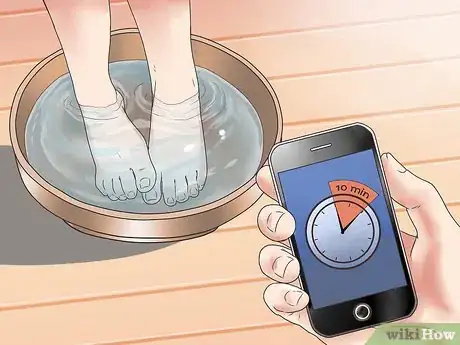

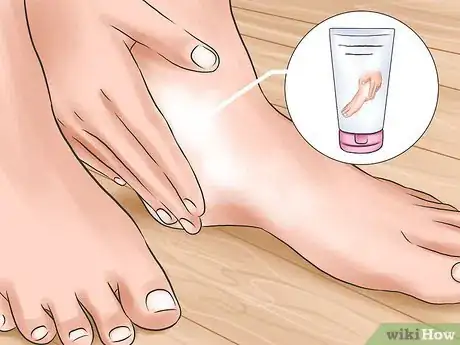
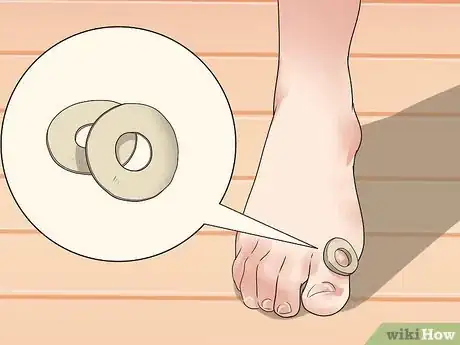

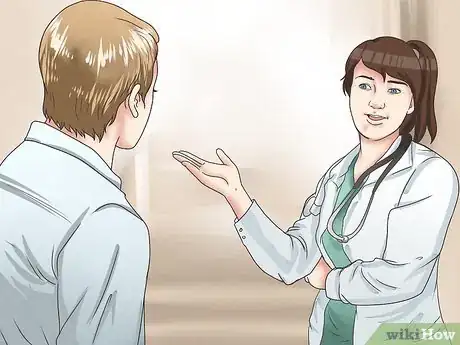
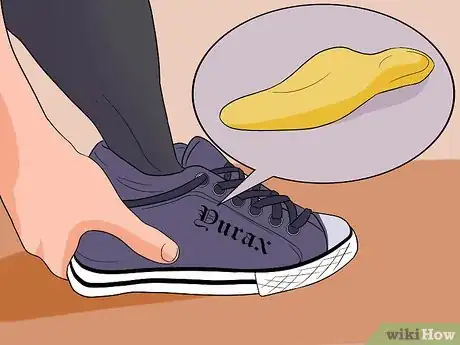
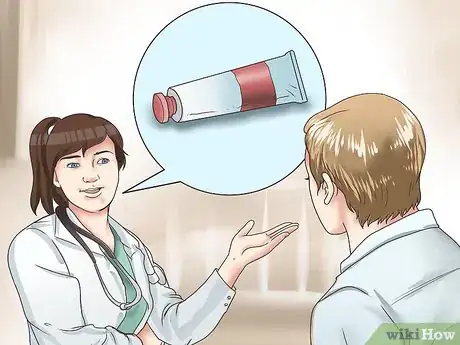

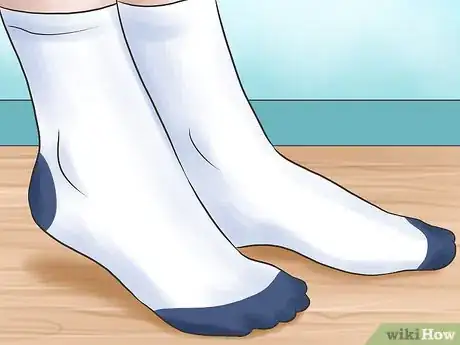
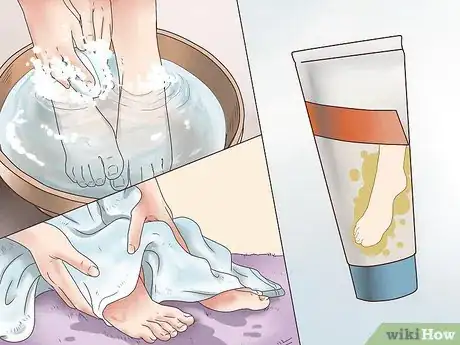
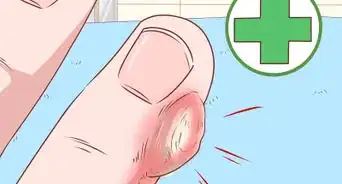
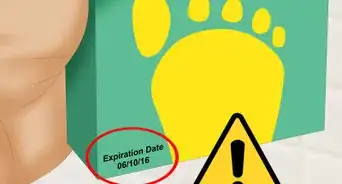
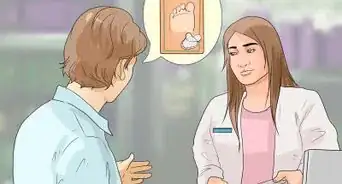
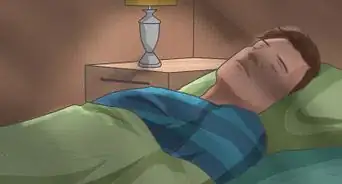
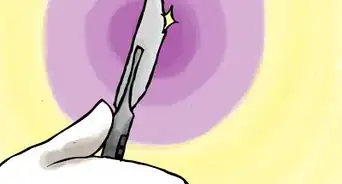

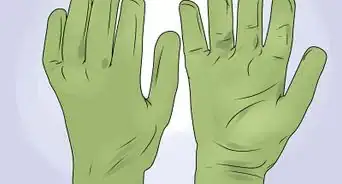
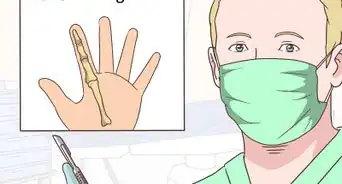
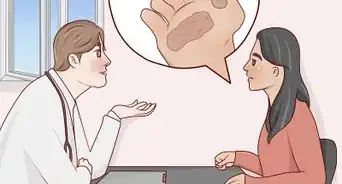

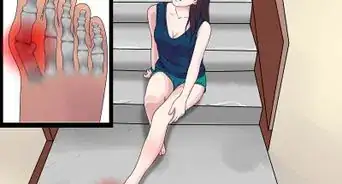
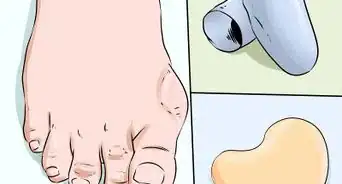












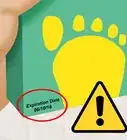
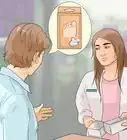




































Medical Disclaimer
The content of this article is not intended to be a substitute for professional medical advice, examination, diagnosis, or treatment. You should always contact your doctor or other qualified healthcare professional before starting, changing, or stopping any kind of health treatment.
Read More...